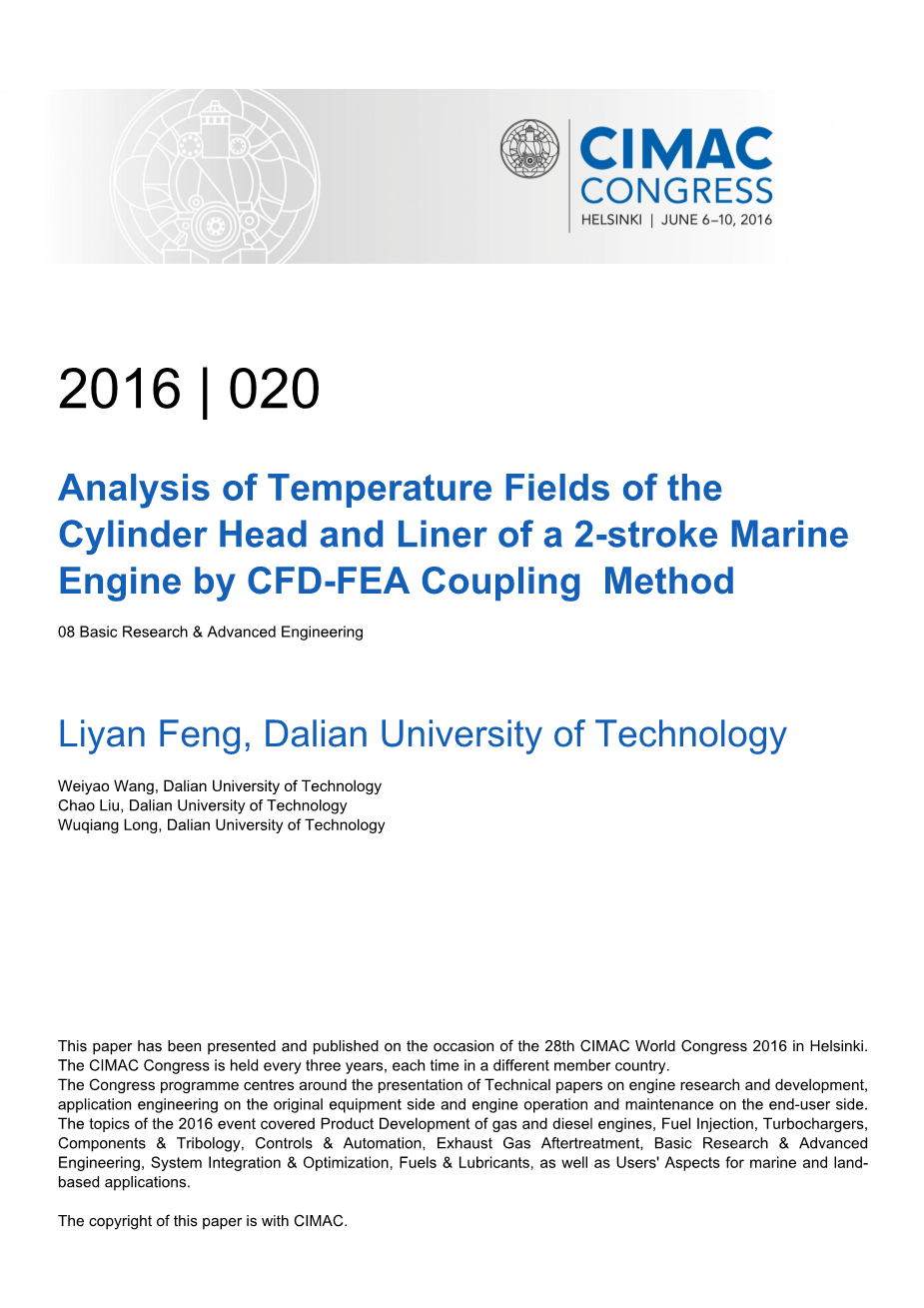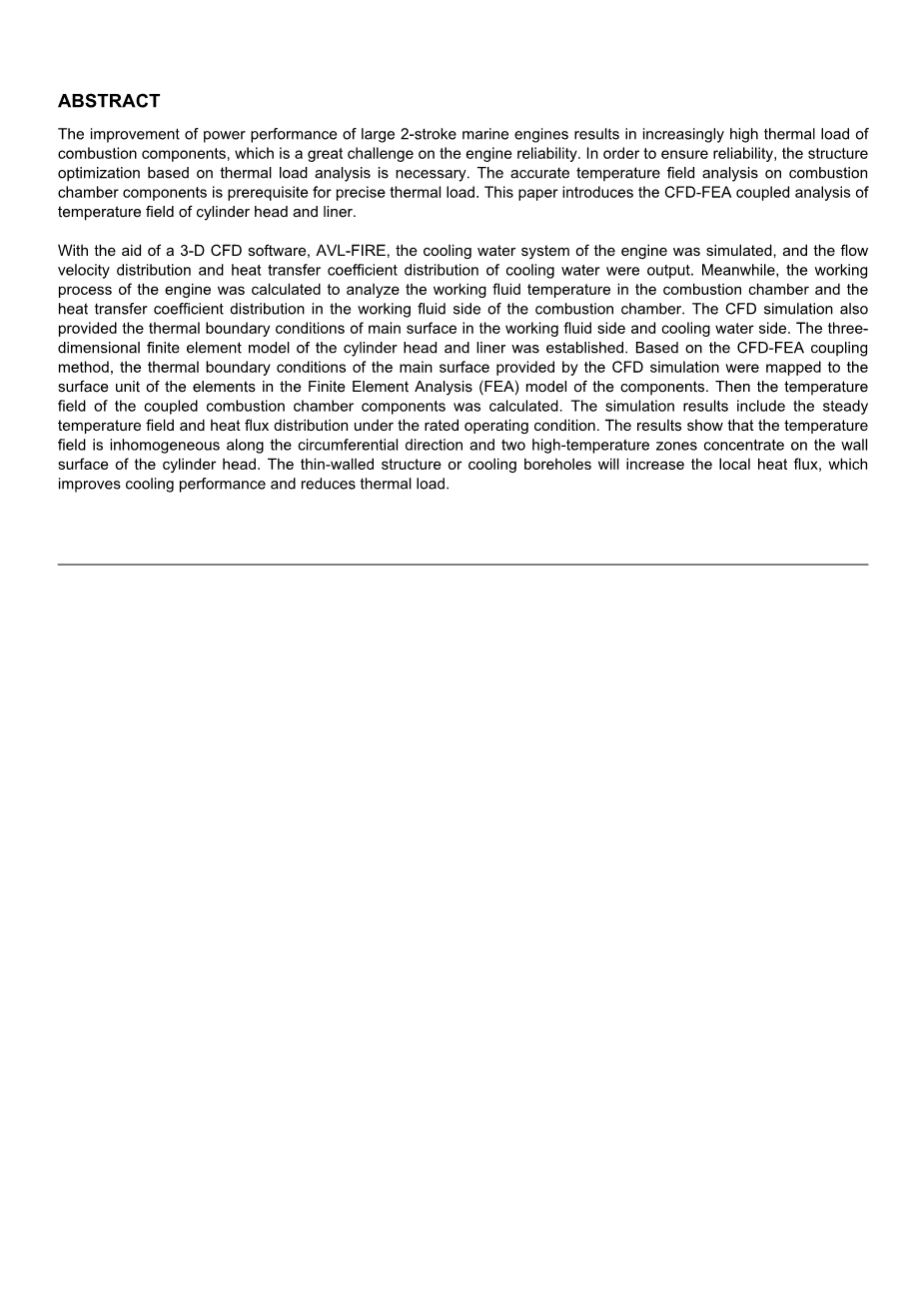

英语原文共 17 页,剩余内容已隐藏,支付完成后下载完整资料
2016 | 020
Analysis of Temperature Fields of the Cylinder Head and Liner of a 2-stroke Marine Engine by CFD-FEA Coupling Method
基于CFD-FEA耦合方法对二冲程船用发动机气缸盖和衬套的温度场分析
Liyan Feng,Dalian University of Technology
冯丽燕,大连理工大学
Weiyao Wang, Dalian University of Technology
Chao Liu, Dalian University of Technology
Wuqiang Long, Dalian University of Technology
Wang Weiyao,大连理工大学
Liu Chao,大连理工大学
Long Wuqiang,大连理工大学
This paper has been presented and published on the occasion of the 28th CIMAC World Congress 2016 in Helsinki. The CIMAC Congress is held every three years, each time in a different member country. The Congress programme centres around the presentation of Technical papers on engine research and development, application engineering on the original equipment side and engine operation and maintenance on the end-user side. The topics of the 2016 event covered Product Development of gas and diesel engines, Fuel Injection, Turbochargers, Components amp; Tribology, Controls amp; Automation, Exhaust Gas Aftertreatment, Basic Research amp; Advanced Engineering, System Integration amp; Optimization, Fuels amp; Lubricants, as well as Users Aspects for marine and land-based applications.
本文已在2016年第28届CIMAC世界大会在赫尔辛基举行的时候发表和出版。CIMAC大会每三年举行一次,每次都在不同的成员国举行。大会计划围绕发动机研发、应用工程在原设备端以及在最终用户端的发动机运行和维护技术论文的介绍。2016年活动的主题包括燃气和柴油发动机的产品开发、燃油喷射、涡轮增压器、组件和摩擦学、控制和自动化、废气后处理、基础研究和先进工程、系统集成和优化、燃料和润滑油、海洋和陆基应用等内容。
ABSTRACT
概述
The improvement of power performance of large 2-stroke marine engines results in increasingly high thermal load of combustion components, which is a great challenge on the engine reliability. In order to ensure reliability, the structure optimization based on thermal load analysis is necessary. The accurate temperature field analysis on combustion chamber components is prerequisite for precise thermal load. This paper introduces the CFD-FEA coupled analysis of temperature field of cylinder head and liner.
大型二冲程船用发动机的功率的提高导致燃烧部件的热负荷越来越高,这对发动机可靠性是很大的挑战。为了确保可靠性,基于热负荷分析的结构优化是必要的。对燃烧室部件精确的温度场分析是确定热负荷的先决条件。本文介绍了气缸盖和衬套温度场的CFD-FEA耦合分析。
With the aid of a 3-D CFD software, AVL-FIRE, the cooling water system of the engine was simulated, and the flow velocity distribution and heat transfer coefficient distribution of cooling water were output. Meanwhile, the working process of the engine was calculated to analyze the working fluid temperature in the combustion chamber and the heat transfer coefficient distribution in the working fluid side of the combustion chamber. The CFD simulation also provided the thermal boundary conditions of main surface in the working fluid side and cooling water side. The three-dimensional finite element model of the cylinder head and liner was established. Based on the CFD-FEA coupling method, the thermal boundary conditions of the main surface provided by the CFD simulation were mapped to the surface unit of the elements in the Finite Element Analysis (FEA) model of the components. Then the temperature field of the coupled combustion chamber components was calculated. The simulation results include the steady temperature field and heat flux distribution under the rated operating condition. The results show that the temperature field is inhomogeneous along the circumferential direction and two high-temperature zones concentrate on the wall surface of the cylinder head. The thin-walled structure or cooling boreholes will increase the local heat flux, which improves cooling performance and reduces thermal load.
在3-D CFD软件AVL-FIRE的帮助下,模拟发动机的冷却水系统、输出冷却水的流速分布和传热系数分布,同时,计算发动机的工作过程,以分析燃烧室中的工作流体温度和燃烧室的工作流体中的传热系数分布。CFD模拟还提供了工作流体和冷却水的主表面热边界条件。建立了气缸盖和衬套的三维有限元模型。基于CFD-FEA耦合方法,CFD模拟提供的主表面热边界条件被映射到元件的有限元分析(FEA)模型中元素的单位表面,然后计算耦合的燃烧室部件温度场。模拟结果包括在额定工况下的稳定温度场和热通量分布。结果表明,温度场沿圆周方向不均匀,两个高温区集中在气缸盖的壁面上。薄壁结构或冷却钻孔将增加局部热通量,这提高了冷却性能并降低了热负荷。
INTRODUCTION
简介
With the improvement of power performance of modern marine diesel engines, the mechanical and thermal loads of combustion chamber components are steadily increasing. To ensure the reliability of these components is a great challenge to engine developers. Developers must further optimize the structure of the components to reduce thermal loads, or intensify cooling to reduce working temperatures of the components, or use new materials to withstand increasingly higher working temperatures of the components. Before doing such work, a precise analysis of the temperature fields of the components is necessary. The combustion chamber components of a cylinder of a 2-stroke marine diesel engine include a cylinder head, an exhaust valve, a liner and a piston. These components directly contact with high temperature working fluid on the combustion chamber side and low temperature cooling fluid on the cooling system side. The precision of the analysis of the temperature fields of these components is mostly determined by the accuracy of the thermal boundary conditions of them. On the cooling system side, the flow status is basically steady. The analysts only need to solve problems of space variation. However, on the combustion chamber side, the flow and heat status of working fluid are changing rapidly. The analysts face to transient problems and must solve complex processes of temporal and spatial variations. The solution of these problems depends on the precise computation of the working process of the engine. However, during the long history of diesel engine development, developer could only use empirical equations to roughly estimate the heat transfer in combustion chambers. Only when 3-D Computational Fluid Dynamics (CFD) method is widely used in the recent years, a precise computation of heat release and heat transfer is possible. This paper introduces the authorsrsquo; work on the analysis of the thermal loads of a 2-stroke marine diesel
剩余内容已隐藏,支付完成后下载完整资料
资料编号:[138163],资料为PDF文档或Word文档,PDF文档可免费转换为Word
课题毕业论文、外文翻译、任务书、文献综述、开题报告、程序设计、图纸设计等资料可联系客服协助查找。


